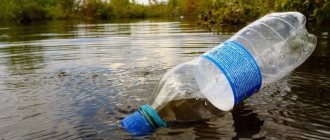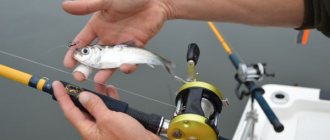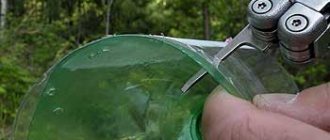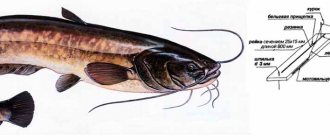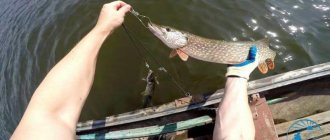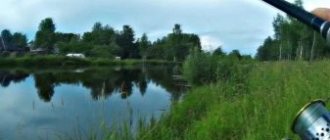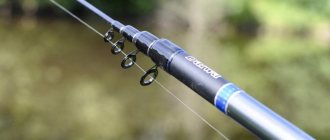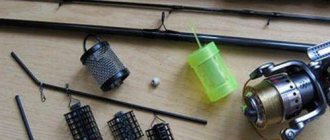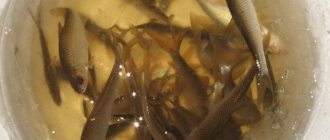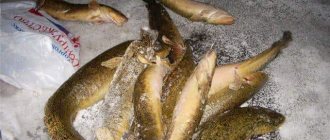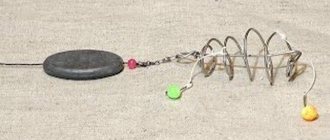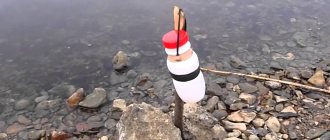The article provides a description of the gear and fishing with a live bait, a catchy “bottle”. “Victory over spinning”
The beginning of autumn has always been considered the most successful and productive period in catching predators with a spinning rod. A particularly good “gorging” of pike and asp occurs during the so-called “Indian summer”, when the shores and islands glow with the gold of birch groves, and in the foggy haze light cobwebs fly and hang on the face - the companions of the “Indian summer”. It smells like smoke, although it doesn’t necessarily smell like something is burning, but this elusive smell is inherent in golden autumn.
The most productive during this period are usually large bodies of water, for example, the Volga and the flood zone of the Volga hydroelectric power stations. These floods with islands and flooded forests have always been famous for the abundance of underwater predators of all kinds, especially pike and perch. Small rivers are somewhat capricious in this regard and it is more difficult to find a key for them in the form of a catchable bait. On some of them, pike take artificial baits only in places. And the choice of bait on such rivers can be a long and unpredictable task, when today the pike grabs a white “Atom”, and tomorrow give it a golden “spinner”. Sometimes pike here completely ignore artificial baits. And then it seems that the river has become empty of fish, and there is no predator in it, if nearby, literally ten meters away, a local fisherman had not suddenly pulled out a pike that had grabbed the bait on the tee of the donkey.
The competition between spinning rods and live bait gear has been going on for a long time. And even with the advent of very natural-looking baits that look like live fish, such a competition often ends in victory for live bait gear, since any predator will choose its natural food first. And this is most often silver roach, bleak, gudgeon, and less often perch. Even in muddy water or at night, predators are excellent at finding prey by the vibrations and vibrations emitted by the potential prey, and the predator receives these signals with its lateral sensor line.
And during this period, a simple tackle, which is called a “bottle” and other similar names because of the plastic bottle, which is the simplest spinning reel, is very successful. And now, in order.
What is the essence of bottle fishing?
Few people know about the bottle tackle; it was invented relatively recently, but it is rapidly gaining popularity. In fact, catching pike with a bottle is identical to setting up circles, only the tackle itself is much simplified.
The most successful time to use gear is early autumn; in summer, catching a predator will be less successful. Although you should not categorically refuse to use the gear, a successful outcome depends on weather conditions, pressure indicators, and the reservoir itself.
Features of using a bottle as equipment are as follows:
- they use more large trophy specimens to catch;
- the tackle is suitable for fishing large reservoirs, small lakes are not suitable for bottle fishing;
- fishing is carried out both in still water and in the current;
- There are two fishing options with gear: active and passive;
- Even a beginner in fishing can handle installation and use.
It is not at all necessary to make devices from home; it can be made without any problems on the shore while live bait is being caught.
Fishing for carp on a nipple, we turn non-sporting gear into sports gear
The feeding method is a civilized form of pacifier.
The difference is that the hook, which is hidden in the bait, has bait (boilie or corn), and the food is not plasticine-like, but gradually swells and disintegrates at the bottom, creating a mound with bait on the top . The nipple is a non-sporting tackle for catching carp and crucian carp. Its unsporting nature lies in the effect of an accidental bite. The carp is caught by the hooks without eating the bait, that is, the food - viscous bait, inside of which there are several hooks with foam. Polystyrene foam makes the hooks weightless and almost invisible to the touch. The carp sucks up the food, and along with it the hooks, then tries to leave and is spotted.
- Making nipple equipment for carp ↓
- Nipple fishing technique ↓
Also, if the feeder was made with a heavy sinker, the self-hooking effect will work, so this is another point in the list of unsportsmanlike qualities of this gear. Meanwhile, it is really very effective. There are many cases where the carp eats all the bait, but does not eat the bait.
Watch an interesting video using a PVA bag and a floating boilie (not a nipple), and you will see how the carp choosily eats all the bait, but does not touch the bait, but there is more than one fish there.
Therefore, we conclude that the nipple tackle is an unsportsmanlike method of fishing and we urge everyone who catches carp with such tackle to be sure to release the prey back, give it another chance and let it enjoy life.
Collecting tackle
The pike bottle has a very simple structure and components; as already mentioned, even a child can handle the installation. However, it is worth understanding that there are two types of gear:
- for fishing from the shoreline;
- for fishing from a boat.
The operating principle of both options will be identical, but there are still some features in the formation of the gear. The equipment is assembled from the following components:
| tackle component | for fishing from shore | for fishing from a boat |
| bottle | for each piece of gear one | one for each piece of gear |
| the basis | nylon cord or fishing line of thick diameters, you will need about 15-25 m in total | nylon cord or thick monk, 8-10 m will be enough |
| leash | steel, up to 25 cm long | steel, 25 cm long |
| sinker | 20-100 g weight | up to 100 g weight |
| hook | tee or double | tee or double |
Having studied the indicators, we can safely say that the installation will differ only in the amount of the wound base. In all other respects, there is no difference at all in the components of the gear. But you need to know the intricacies of collection for both species.
Fishing from the shoreline
A distinctive feature of bottle fishing from the shore is the fixation of the gear in the vegetation. Abandoned gear is simply tied to bushes or a tree that is located on the shore for reliability. Its advantage is that it can be set overnight and only checked for catch in the morning.
In addition, installation has the following features:
- additionally, 5-8 m of cord or fishing line are wound for fastening;
- the sinker is attached at the end of the tackle; it does not have to be made sliding;
- the leash is knitted to the base half a meter above the load securing;
- To make the bite more noticeable, fill the bottle 2/3 with water.
Another important point will be the presence of aquatic vegetation; the tackle for pike must be installed where there is none at all. This will help avoid tangling the bait and the base.
Such passive fishing often helps out on camping trips; resting on the banks of rivers with such equipment will help you get hold of decent specimens of the predator.
Fishing from a boat
To catch pike with a bottle from a watercraft, the warps are wound less than when fishing from the shore. This is due to the fact that in this case the tackle is not tied anywhere, but placement is carried out directly in the chosen place, where you can swim by boat.
For greater reliability of the tackle, an additional hole is made in the neck or the cork itself, through which the base is tied.
The end of the tackle is a sinker; its weight can reach 100 g, but it must always remain sliding. Craftsmen often use various objects that help the gear stay in its intended place.
The leash and hook are attached as standard, for this you should study the depths being fished a little, and only then carry out installation.
What is needed to make this gear?
— We will need a regular plastic bottle. Mineral water, soda, etc. are sold in such containers, so finding it will not be difficult. Grandpa takes bottles from the garbage that fishermen scatter along the banks.
Friends, take care of nature, take your trash with you and throw it in the trash. It's a shame when grandpa goes and collects trash for careless vacationers
For this gear, it is best to use bottles with a volume of 1.5 liters or more.
— Fishing line or braid. As the fisherman grandfather said: “Take any thickness, the main thing is that it is 10 meters.” This line must be wound around the hole (recess) in the middle of the bottle.
- Cargo. I didn’t have any scales with me, but off the top of my head, grandpa used weights weighing 100-150 grams.
- Leash. His leashes were homemade, made of thick fishing line.
— You need 2 rubber bands. One serves as a stopper when unwinding. The second serves as a shock absorber when biting and is located near the sinker.
— All equipment can be equipped with swivels with carabiners for greater mobility. But my “teacher” had everything simply tied with fishing knots.
— As for the hooks, each fisherman hooks the fry in his own way. And the number of hooks is individual. Grandpa had one double in the mouth of each baitfish.
How to fish with this bait bottle? (As the fisherman grandfather did)
1. A donka 30 meters long was wound on a regular reel.
2. Having counted 10 meters from the equipment, a bottle is tied by the neck.
3. Approximately 200 ml of water is poured into the bottle.
4. 10 meters of fishing line that has been reeled off is wound onto a narrow part in the middle of the bottle and secured with an elastic band.
5. The remaining fishing line is unwound from the reel and it is stuck firmly into the ground (without fishing line).
6. Next we attach live bait.
7. Casting is done as follows. A bottle is taken in the hand (at the place where the fishing line is wound), so that the equipment hangs below and a cast is made according to the principle of a pendulum. The cast is made along the entire length of the fishing line remaining on the shore.
When falling on the water, the load, under the influence of gravity, will unwind the required amount of fishing line from under the elastic stopper and fall to the bottom.
The tackle is abandoned, we are waiting for a bite! Sometimes you have to wait quite a long time.
Do-it-yourself bottle fishing tackle
Bottle fishing on any body of water begins with collecting gear. You can do this in advance at home, or you can experiment on the shore. Most often, this is done in cases where capture by other means does not bring results.
To make a copy you need:
- Usually everything is attached to a plastic bottle, but its capacity can vary from 0.5 liters to 5 liters, it all depends on the depth of the reservoir and the live bait used;
- It is recommended to use thick-diameter fishing line as a base, but it is better to take a nylon cord;
- the sinker is chosen based on the bait, but the depth of the fished body of water is also important, and they also pay attention to the current;
- A leash must be installed; the best option is a steel one;
- hooks are used in single, double and triple, it all depends on the personal preference of the fisherman, but single is usually relevant in still water.
There is also a preparatory process: the containers, namely the bottles, are thoroughly washed beforehand in order to rid them of foreign odors. In addition to the above components, rubber bands for money are additionally used, this will help fix the base better.
How to increase your fish catch?
Over 7 years of active fishing, I have found dozens of ways to improve the bite. Here are the most effective ones:
- Bite activator . This pheromone additive attracts fish most strongly in cold and warm water. Discussion of the bite activator “Hungry Fish”.
- Increased gear sensitivity. Read the appropriate manuals for your specific type of gear.
- Pheromone -based lures .
The best tackle for crucian carp
Nowadays, crucian carp are increasingly caught using gear with a feeder. This method has a number of advantages:
- When it is formed, rather large hooks are usually placed, which makes it possible to catch only adult individuals.
- A variety of baits allow you to maximize your catch size.
- Efficient in any weather.
Anglers who used the feeder for the first time give the following reviews:
There are several effective types of equipment for catching crucian carp, here are the most popular of them:
Float tackle for crucian carp is divided into two types:
- the blind one is made on a fly rod 4-6 meters long. The float is attached to the fishing line along with a clamping weight under it. Next, a leash with a hook is knitted. The float should be placed sensitively, because the bite of crucian carp can be very sluggish.
- Sliding tackle is usually designed for long casting. It uses a sliding float with a large load, which is locked with rubber stops. With their help, the depth at which the hook with bait will be placed is also adjusted.
Tackle “Crucian carp killer”
This gear is quite common among fishermen. It consists of:
- 1-4 feeders (they can be of different sizes);
- leashes with hooks;
- load 10-50 g.
What other fish are caught this way?
The bottle is used to catch not only pike with live bait; in the current, you can lure another predator in the same way:
- pike perch;
- soma;
- carp
But even with this opportunity, you can even catch live bait with a bottle from the shore. The installation is made from two bottles, the bottom of one is cut off, the neck of the second is cut off in the form of a funnel, and the cross-sectional diameter must be the same. Next, the funnel is inserted into the bottle cut off at the bottom, holes are made using an awl, and parts of the trap are secured with a cord or fishing line.
The finished product is secured on sticks at the bottom of the shallows, having previously poured bread crumb, porridge or a little bit of bait inside and left overnight. In the morning they check the trap and take the catch.
Catching a predator with a bottle is as easy as shelling pears; even a beginner can assemble and display this rig. The pike will definitely appreciate the efforts and will definitely want to feast on the live bait offered to it.
Catching pike with live bait at different times of the year
Pike, like most predators, is a restless creature; its activity largely depends on the time of year, temperature and atmospheric pressure. Therefore, fishing in different seasons has its own characteristics that the fisherman needs to know.
Spring
Let's start with the spring period. In spring, pike are most often found at shallow depths and hunt for small fish while camouflaging themselves in the grass. When choosing a place for an ambush, the predator tries to have good visibility, but it is quite difficult to notice it. So she stands and waits until the prey comes into her field of vision. This is followed by a powerful and fast attack, which in most cases leaves the victim no chance. Based on this behavior of the predator, live bait should be installed near a large accumulation of grass. If fishing takes place on a lake, then it is best to look for especially large pike near underwater snags overgrown with vegetation, on the edges (depth differences), as well as in those places where a stream flows into the lake. As for river fishing, in this case, pike can most often be found near underwater holes, whirlpools, and also in places where there is a difference in depth.
March
This month is considered one of the best for pike fishing. The thing is that after winter (when the fish is inactive), the predator has its first meal. At this time, the pike very greedily grabs any bait.
April
In April, a powerful flood most often begins and therefore the intensity of pike biting decreases. This happens because a large amount of dirt gets into the reservoir along with large amounts of water. This reduces visibility and therefore during this month it is best to fish with baits that can make some noise underwater. Fishing with live bait does not bring good results at this time.
May
This month can give the angler an excellent catch. The water in rivers and lakes is warming up and a lot of fish are moving into shallow waters
In May, pike takes bait greedily, even without paying attention to the hook pricks
Summer
In the summer, pike fishing with live bait is possible throughout the entire body of water. The predator especially often sets up ambushes at the exit from holes, or near flooded trees and snags. If there is a pronounced thermocline in a reservoir, the fisherman should determine its boundaries. Since temperature changes seriously affect the activity of both live bait and pike. An excellent place for fishing in the summer can be a bend in the river where the current weakens. In such a place there are always a lot of fry, which can attract a predator.
June
This month it gets really hot, which, of course, affects the behavior of the fish. However, in the first half of June, pike are caught quite well, showing a stable bite. Afterwards, her behavior changes; she spends most of the day in the grass, or in the depths. Therefore, the best bite during this period is observed in the early morning.
July
In July, the highest water temperature is observed and therefore the activity of the predator decreases. In addition, a large amount of algae appears in the water and the amount of oxygen decreases. During this period, you can catch pike at night or early in the morning. During the day the fish hardly bite.
August
The water in the river begins to cool, which leads to more active behavior of the predator. In the first half of the month, the bite may not be too intense. However, the second half of September can offer excellent fishing.
Autumn
In autumn, the most successful pike fishing occurs in reservoirs with great depths. It is the edge or exit from the pit that becomes a favorite place for pike in the fall. Here she hunts fish, which rise to warm shallow water in the morning, and in the evening, on the contrary, descend into not yet completely cold pits.
September
This month can bring trophy catch to the fisherman, as large pike at this time begin to feed heavily in preparation for winter. The fish bite greedily and can take bait anywhere in the reservoir.
October
A great month for catching pike with live bait with bottom rods and spinning rods. Moreover, large pikes are often caught on the hook.
November
During this month you can catch the biggest fish. The best time for fishing is early in the morning. At this time, large pike actively feed, going to shallow depths.
Winter
In winter, pike, unlike many fish species, does not hibernate, however, its activity noticeably decreases. Therefore, it is possible to catch pike at this time of year, but a large catch is extremely rare. For winter fishing with live bait, girders are most often used, which are quite effective at this time of year.
Tips from fishermen when catching catfish using bottom tackle
- If you decide that you will catch catfish using bottom tackle with a rod, then first of all you should take care of a stand for the rod.
- The most successful time for catching catfish with bottom tackle is at night. Night is the very time of day when the catfish begins to lead an active lifestyle and goes hunting
- When you go catching catfish, don’t forget to take a knife with you. After all, it often happens that during the struggle, the catfish resists so actively that it winds the cord or fishing line around the fisherman’s hand or leg. And there are cases when the catfish wins, and the fisherman ends up in the water. This is where a well-sharpened knife will help you.
- If you go fishing with bottom tackle at depth in a boat, take a friend with you to help. And besides, the time of tracking and catching catfish with a friend is much more enjoyable.
Help the channel? It's simple:
- Subscribe
- Like
- Click the share button and share on social networks
This is the only way we can develop further!
Fishing and a bottle - tackle
This unusual incident happened a couple of years ago, but I’m just now getting around to telling you about it.
Fishing with bottles
I then dreamed of going fishing for a whole week. I have already collected the gear, stocked up on bait, and prepared the bait. Yes, things didn’t go away. Finally decided - on Sunday! I hardly slept that night: the floats danced before my eyes, and the healthy fish still couldn’t get hooked. Real fishermen will understand what a state it is when you know: literally a few hours separate you from your favorite activity. Dawn had barely broken, and I was already on the river. No sleep in either eye. I sit quietly on the shore. It's early morning. The bite is not bad. In a feeding area, a hybrid of half a kilo regularly sits on a maggot. The fish tank becomes pleasantly heavier with each fish. Such a bite does not happen every day, and therefore I did not immediately notice that something strange was happening on the opposite bank. A boat was slowly floating along the river: a guy was rowing, but his companion was active: waving her arms and dropping something overboard from time to time.
There is, of course, nothing unusual about a guy taking a girl on a boat, no. And the young man himself did not raise any questions: he sat on the oars and rowed slowly. But the actions of his companion first caused surprise, and then indignation. Well, how would you react if you saw that very close to the place where respectable fishermen are sitting with their fishing rods, someone will start throwing plastic bottles on the water. And not just one or two, as unfortunately, but still happens when idle revelers ride on boats, but about a dozen - one after another, that are lined up in a chain in the wake of the boat. In general, irritation grew in my soul.
They scattered bottles, which means they anchored nearby. They are sitting in a boat, their eyes are sore, bottles are floating in the water. The mood is downhill, and even the catch is no longer so pleasing. Who likes to see their float in the middle of the garbage? Okay, at least they behave quietly - they don’t scare the fish. It’s just... It’s strange how these bottles float. They don’t spread far, and they stay in the water too neatly, or something... Bottoms up. And then the plastic behaved just like a float - it swayed lazily a couple of times and floated along the waves... It stopped for a while and swam again... The guy and girl in the boat quickly weighed anchor and hurried to the bottle they had thrown. Imagine my surprise when the container tore out of their hands and, practically going under the water, again vigorously tore to the side. About five times the boat had to catch up with the recalcitrant bottle until it finally fell into his hands. On the shore, almost the entire fishing fraternity watched this action, having abandoned their fishing rods.
I think you already guessed that there was a huge fish literally a meter under the bottle. Pike. A neighbor on the shore a little later, when the passions had subsided, said that this tackle was familiar to him. True, he himself did not fish with a bottle, but he heard what it is and how a plastic bottle can also serve a fisherman in various guises. Interesting? Well, if so, I’ll tell you now.
Plastic bottle - both a circle and a donk
It would be quite logical to start with the unusual gear that I saw on the river. Probably only in Russia, which, as the well-known saying goes: “Cunning in inventions,” could have thought of using outright trash as more than catchy gear. To prepare a mug from a bottle you will need:
- empty plastic bottle with a capacity of 0.5 l - 1 pc.;
- fishing line (diameter and length depend on how deep the pond you choose is, and what kind of fish you plan to catch);
- two pieces of rubber cambric with a diameter of 5–7 mm;
- stationery eraser - 1 pc.;
- piece of cork;
- sinker;
- hook.
In other words, nothing supernatural. Let's start installation.
First the lid. A hole is drilled or burned into it, into which a loop of thick copper wire is inserted using two spacers. It is better to seal the hole with a sealant to prevent water from getting into the bottle. A second one is attached to this loop, with a line clamp.
A blind loop is made on the fishing line, thrown over the bottle, and tightened. Rotating the bottle, we wind the remaining fishing line around it. We put both rubber cambrics on its free end. One will press the fishing line against the lock, the second will act as a stopper on the fishing line. An elastic band will fix the fishing line at the desired depth. When the fish bites, the loop will easily slip out from under the elastic and the line will unwind, allowing the fish to be hooked. I don’t think there will be any problems with the hook: it all depends on the attachment. For live bait - a double or tee, for a vegetable bait a single is enough.
And now the key point: if the bottle is used as a circle, then a small load will be enough. And if you plan to install donks, then you will need a longer fishing line and a larger load. Ideally, in the form of a sausage (so that it can be easily transported by simply placing the same bottle) 250–300 grams.
What's good about this kind of gear? Firstly, if you prefer to go fishing light, then it’s enough to take gear and prepared bottle caps with you. It won’t be a problem to find the plastic itself near every body of water. However, if you have free space, you can take the bottles with you. Then it is very convenient to transport already assembled equipment in them.
This gear is light, buoyant, and, importantly, after fishing, you can simply organize a cache on the shore so as not to take bottles and mugs with you again. And if you don’t plan to return to this body of water in the near future, then after removing the fishing line, you can simply burn the rest on a fire so as not to litter the banks. And you can catch absolutely any fish with this tackle - from peaceful carp, crucian carp and bream to predatory pike, pike perch or asp. Just one thing: when catching a predator, you need to make sure that the leash is metal.
Cover-feeder
By the way, about catching peaceful fish. A plastic bottle cap, as it turns out, is an ideal material for creating a unique and incredibly catchy lid-feeder tackle. It is excellent for catching bream, carp, silver bream and roach.
All you need to make such a rig is a lead disc-weight, a carabiner, two or three hooks, some fishing line for leashes and the lid itself.
The lid is drilled out in the center and a thick fishing line with loops at each end is inserted into it. The outer loop is equipped with a carabiner, and the inner loop is equipped with leashes with hooks. A weight washer, repeating the shape and diameter of the bottom of the lid, is fixed on this surface.
The convenience of this gear is that the lid is both a weighting agent and a feeder. The inner container is filled with porridge, in which hooks with bait (maggot, corn, dough, bread crust) are drowned, and thrown to the fishing spot. You can use both a spinning rod and an ordinary telescopic fishing rod for this.
Top for catching live bait
When catching a predator already on the shore, the problem of catching live bait periodically arises. A small fish takes the bait reluctantly, and sometimes it’s quite the opposite - too willingly, but not a small fish. Fish, of course, is also needed for fish soup, but for seducing a predator, a half-kilogram crucian carp is not the best option.
This is where plastic bottles come to the rescue again. True, you will have to assemble the little one at home. This will require very little time and effort, as well as two two-liter bottles. The easiest way to solder plastic parts is on an electric stove.
So, the bottles are cut. The main thing is that the cut line is as even as possible, because then the parts will have to be spliced. We completely remove both the neck and the bottom of one bottle, and remove only the neck from the second bottle.
We perforate the “body” of the first bottle using a sharpened tube with a diameter of 5 mm. If it is not possible to find such a tube, you can simply use a soldering iron. Then we splice the resulting parts together. You will also need the neck of one of the bottles. It will need to be turned over and inserted into the perforated bottle. You will get a kind of funnel. The seam should also be soldered, and then three holes should be made a centimeter below the soldering line so that the bridle can be secured. The tackle is ready. Doesn't remind you of anything? Right! A smaller version of the one that was called “muzzle” among fishermen. We put a few pieces of bread inside for bait and wait for a sufficient amount of bait to be collected. However, the little wren may not be taken out of the water for a long time. They took as many fish as they needed and put them back into the water. This way the bait will be caught, and the live bait will be active all the time. Those fish that are not useful will simply go back to their native element at the end of fishing.
Craftsmen use such bottles to make a container for storing floats and a device for catching aquatic insects. When going to a pond for several days, they store water, cereals, salt, sugar in them, and hide matches from the rain. I knew one Kulibin who even assembled a boat from plastic bottles. The strength of the material, however, was only enough for one season, but it was cheap, unusual, and the carrying capacity was such that store-bought watercraft could never even dream of.
Continuing the story
I found out about all this later - when I got into a conversation with a fisherman neighbor. And that day, with my mouth open, I watched unusual fishermen who, from time to time, swam up to one “bitten” bottle, then to the second. And, to be honest, the catch was amazing in number, size, and variety. The guys apparently used different attachments and bait, because from fairly widely scattered gear they right before my eyes, in addition to that first pike, took several more spotted beauties, the company of which included a three-kilogram pike perch, a good carp, a large crucian carp and a dozen qualifying perches.
Needless to say, the pocket of my fishing backpack now also contains a couple of half-liter bottles and a dozen caps with a lock. For good luck.
Arseny Mavrin, Kazan
Postavusha
A simple bottom tackle for catfish is a reel with a wound strong cord, which is equipped with a sinker and a hook. In principle, similar gear is used when casting from a boat. Some fishermen use a large inertial reel like the domestic “Nevskaya” to wind the line, which is mounted on a metal pin for installation on the river bank.
Manufacturing
Now let's talk about how to make donka for catfish. First, let's decide how we will store the cord: on a reel or reel. If you have an old grandfather's inertia, we'll make great use of it. Let's attach the reel to a metal pin; you can use an old ski pole or an aluminum slingshot under the rod as it.
You can also wind the cord on a reel. If you have the time, the right tools and woodworking skills, you can make something similar to what is shown in the first photo. Otherwise, the cord can be wrapped around a suitable piece of foam, board or plywood.
Let us explain why it is the cord, and not the fishing line, and the cord is special, not fishing braid, but nylon twisted thread.
The fact is that fishing such gear is done without using a reel, directly by hand. When using monofilament fishing line, even the thickest one, cuts on your hands are likely, because the caught catfish resists strongly. The nylon cord is much softer in this regard, and, therefore, better.
So, we wound 40-50 meters of cord on a reel or reel, and it’s time to tie the underbrush. This is a piece of one or two thick monofilaments of 0.4-0.7 millimeters. It is placed so as not to scare away the catfish from the bait with a thick, noticeable cord.
Advice!
It is most convenient to tie two pieces of fishing line, especially of different quality and thickness, using two sliding knots!
Next, you can attach a leash or immediately tie a hook to the catfish; it should be a match for the owner of the river - large, thick and durable.
Tactics and fishing techniques
Let's move on to talking about how to catch catfish with this type of donka, let's start with the tactics of the process. This fishing is quite passive, so a lot of gear is placed on the shore, up to ten pieces at intervals of 10-20 meters between them. They are baited with a variety of baits, because the river owner may have different gastronomic preferences.
Tactically, catfish fishing can be done in two ways. In the first one, the fish are abandoned overnight and are not monitored, but in the morning they come to check the gear. In the second option, the bait stations are equipped with sound and light alarms, and the fishermen sit comfortably around the fire and wait for bites.
Fishing technique
In most situations, pike are caught using a bottle from a boat and much less often from the shore. Fishing for toothy predators from a swimming device can be done in two ways: active or passive. If the hunt is active, then, after completing the installation of gear, the angler should remain in the immediate vicinity to wait for bites. As soon as the pike grabs the bait, it will reel in the fishing line.
In this case, the weight will fall to the bottom of the reservoir, and the bottle will lie on the water surface.
As soon as the fisherman notices this, he will definitely need to get close to the reacting gear in a boat. After this, you will need to make a hook, and then start fishing for the caught trophy. If the pike behaves quite actively, then it can rush violently from one side to the other in the water.
When a pike is overly active, catching it with a bottle is not so easy. To pull out a toothy predator, the angler will need some skill, since in this situation help will not come from either a rod or a reel with a friction brake.
If the angler resorts to the passive method of catching pike, then it will be enough to place the bottles in the water area selected for hunting. After this, they will need to be checked in a few hours. At this moment, the fisherman will need to get pike, which during this time managed to swallow live bait and ended up on the hook. Events of this type require a minimum amount of free time and effort.
However, you definitely need to prepare for the fact that many of the predators in question, which are nevertheless attracted by the bait, will not be detected or will be able to jump off the hook before the fishermen arrive.
Features of fishing from a boat and shore
The technique for catching fish with plastic bottles depends on whether the fishing will take place on the shore or on a boat. In each option, success largely depends on the right location. Promising areas are the boundaries of clear water and algae, the junction of the river with the oxbow lake, bays, entrances and exits from holes, channel edges, and snags.
Shore fishing technique
When fishing from the shore, the angler must not only think about the casting distance of the equipment, but also about the likelihood of successful reeling. Since there is no fishing rod in the gear, the coastal area must be clean. In this case, you will be able to remove the fish from the water without any problems.
The fisherman just has to wait for the bite.
Photo 3. Bottle in firing position.
Features of fishing from a boat
The watercraft provides the angler with more opportunities for fishing with “bottle tackle”. You should start by choosing an interesting site. Bottles can be installed along the shore or in a checkerboard pattern. In any case, you should choose some landmarks so as not to lose your gear.
The boat must be positioned downwind. After installing the first gear, you can start equipping the second bottle. During this time, the boat will be carried to the required distance of 10-15 m. Installation of the entire “squadron” will require a minimum of physical effort and time.
After the bite, it is important to approach the triggered gear as quietly as possible. Otherwise, the fish will get scared and make another jerk. To remove a large trophy from the water, a landing net is required.
Bait for bottom tackle when fishing for catfish
Catfish by nature are an avid predator, which means that the bait for it must be appropriate. To catch it, the best bait will be live bait. Any small fish or frog can be used as live bait. Moreover, the frog is the catfish’s favorite treat. But some avid fishermen use:
- Small pieces of meat. The meat can be any kind: fish, animal or poultry are suitable. Meat with flavor will also work.
- Maggots or worms. An excellent bait made from a worm or maggot will be a small ball with such bait.
- Bird offal
- Mole cricket larvae
- Crustaceans
- Dead small and medium fish
- Dead little birds
- Other representatives of the animal world
